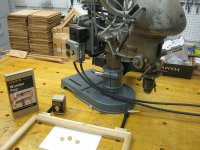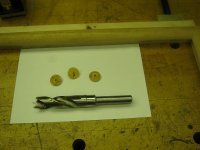jmarkflesher
Member
- Joined
- Aug 22, 2010
- Messages
- 248
I have a OLD 2" thick Rock Maple bench top. It has three rods running front to back and two tightening bolts on each end holding the bread board ends. The best spacing of holes for me was 7" on center. If I find I need more I will double the holes by going 3 1/2" on center. I got the 3/4" bushing from Lee Valley but decided not to use them. The bench top drill press drilled all holes without problems. Layed out the entire top and started sliding drill press to holes. Located the brad point bit on X and drilled through the top without tear out on bottom side. The spurred bit left a thin plug upon exiting bottom.(See Picture) Finished by applying Slip-It inside holes mostly to keep out moisture. Thanks, MARK



